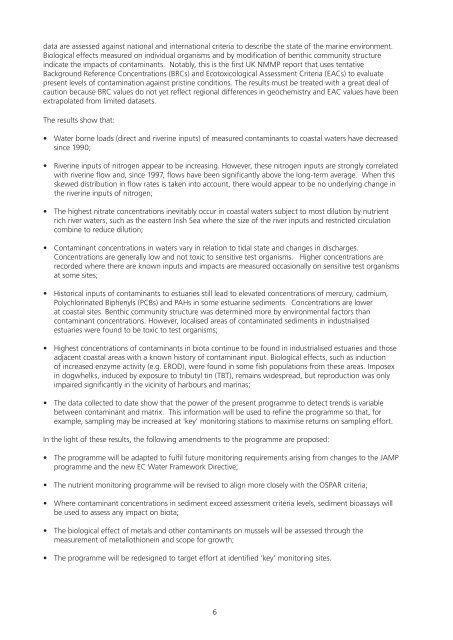UK National Marine Monitoring Programme - Second ... - JNCC - Defra
UK National Marine Monitoring Programme - Second ... - JNCC - Defra
UK National Marine Monitoring Programme - Second ... - JNCC - Defra
Create successful ePaper yourself
Turn your PDF publications into a flip-book with our unique Google optimized e-Paper software.
data are assessed against national and international criteria to describe the state of the marine environment.<br />
Biological effects measured on individual organisms and by modification of benthic community structure<br />
indicate the impacts of contaminants. Notably, this is the first <strong>UK</strong> NMMP report that uses tentative<br />
Background Reference Concentrations (BRCs) and Ecotoxicological Assessment Criteria (EACs) to evaluate<br />
present levels of contamination against pristine conditions. The results must be treated with a great deal of<br />
caution because BRC values do not yet reflect regional differences in geochemistry and EAC values have been<br />
extrapolated from limited datasets.<br />
The results show that:<br />
• Water borne loads (direct and riverine inputs) of measured contaminants to coastal waters have decreased<br />
since 1990;<br />
• Riverine inputs of nitrogen appear to be increasing. However, these nitrogen inputs are strongly correlated<br />
with riverine flow and, since 1997, flows have been significantly above the long-term average. When this<br />
skewed distribution in flow rates is taken into account, there would appear to be no underlying change in<br />
the riverine inputs of nitrogen;<br />
• The highest nitrate concentrations inevitably occur in coastal waters subject to most dilution by nutrient<br />
rich river waters, such as the eastern Irish Sea where the size of the river inputs and restricted circulation<br />
combine to reduce dilution;<br />
• Contaminant concentrations in waters vary in relation to tidal state and changes in discharges.<br />
Concentrations are generally low and not toxic to sensitive test organisms. Higher concentrations are<br />
recorded where there are known inputs and impacts are measured occasionally on sensitive test organisms<br />
at some sites;<br />
• Historical inputs of contaminants to estuaries still lead to elevated concentrations of mercury, cadmium,<br />
Polychlorinated Biphenyls (PCBs) and PAHs in some estuarine sediments. Concentrations are lower<br />
at coastal sites. Benthic community structure was determined more by environmental factors than<br />
contaminant concentrations. However, localised areas of contaminated sediments in industrialised<br />
estuaries were found to be toxic to test organisms;<br />
• Highest concentrations of contaminants in biota continue to be found in industrialised estuaries and those<br />
adjacent coastal areas with a known history of contaminant input. Biological effects, such as induction<br />
of increased enzyme activity (e.g. EROD), were found in some fish populations from these areas. Imposex<br />
in dogwhelks, induced by exposure to tributyl tin (TBT), remains widespread, but reproduction was only<br />
impaired significantly in the vicinity of harbours and marinas;<br />
• The data collected to date show that the power of the present programme to detect trends is variable<br />
between contaminant and matrix. This information will be used to refine the programme so that, for<br />
example, sampling may be increased at 'key' monitoring stations to maximise returns on sampling effort.<br />
In the light of these results, the following amendments to the programme are proposed:<br />
• The programme will be adapted to fulfil future monitoring requirements arising from changes to the JAMP<br />
programme and the new EC Water Framework Directive;<br />
• The nutrient monitoring programme will be revised to align more closely with the OSPAR criteria;<br />
• Where contaminant concentrations in sediment exceed assessment criteria levels, sediment bioassays will<br />
be used to assess any impact on biota;<br />
• The biological effect of metals and other contaminants on mussels will be assessed through the<br />
measurement of metallothionein and scope for growth;<br />
• The programme will be redesigned to target effort at identified ‘key’ monitoring sites.<br />
6

















